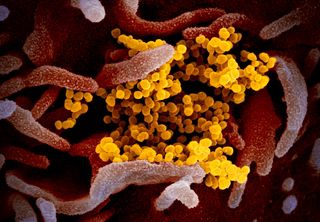How Long Can Pink Eye Live on a Surface
Here'south how long the coronavirus will last on surfaces, and how to disinfect those surfaces.

Editor's Notation: This story was updated on Wed (March 18) to include a alarm not to mix bleach with household cleaning products and to include an update on the publication of the findings. This story was updated on Tuesday (March 24) to note that viral particle RNA was plant upward to 17 days after passengers disembarked the Diamond Princess prowl transport, just experts don't know if they are viable or non.
As the coronavirus outbreak continues to accelerate in the U.S., cleaning supplies are disappearing off the shelves and people are worried about every subway rail, kitchen counter and toilet seat they touch on.
But how long tin can the new coronavirus linger on surfaces, anyhow? The short answer is, we don't know. A new analysis found that the virus tin remain viable in the air for upward to three hours, on copper for upwards to 4 hours, on cardboard upwards to 24 hours and on plastic and stainless steel up to 72 hours. This study was originally published in the preprint database medRxiv on March 11, and now a revised version was published March 17 in The New England Journal of Medicine.
What's more than, SARS-CoV-2 RNA was found on "a multifariousness of surfaces" in cabins of both symptomatic and asymptomatic people who were infected with COVID-19 on the Diamond Princess cruise transport, upward to 17 days after the passengers disembarked, co-ordinate to a new analysis from the Centers for Disease Control and Prevention (CDC). Nonetheless, this was before disinfection procedures took identify and "data cannot exist used to determine whether transmission occurred from contaminated surfaces," according to the analysis. In other words, it's not articulate if the viral particles on these surfaces could have infected people.
Another written report published in February in The Journal of Hospital Infectio n analyzed several dozen previously published papers on human being coronaviruses (other than the new coronavirus) to get a better idea of how long they can survive outside of the torso.
They concluded that if this new coronavirus resembles other human being coronaviruses, such as its "cousins" that crusade SARS and MERS, it can stay on surfaces — such as metal, drinking glass or plastic — for every bit long every bit ix days (In comparison, flu viruses tin last on surfaces for only about 48 hours.)
Simply some of them don't remain active for as long at temperatures higher than 86 degrees Fahrenheit (xxx degrees Celsius). The authors also found that these coronaviruses can exist effectively wiped away by household disinfectants.
For case, disinfectants with 62-71% ethanol, 0.5% hydrogen peroxide or 0.one% sodium hypochlorite (bleach) can "efficiently" inactivate coronaviruses within a minute, according to the study. "We expect a similar effect confronting the 2019-nCoV," the researchers wrote, referring to the new coronavirus. But fifty-fifty though the new coronavirus is a similar strain to the SARS coronavirus, information technology's not clear if information technology volition behave the aforementioned.
Diluted household bleach solutions, booze solutions containing at least 70% booze and most EPA-registered common household disinfectants should be effective at disinfecting surfaces against the coronavirus, according to the CDC. The bleach solution tin be prepared by mixing 5 tablespoons (ane-3rd cup) of bleach per gallon of water or 4 teaspoons of bleach per quart of water, the CDC wrote in a prepare of recommendations.
Please be mindful and use caution when cleaning! #RVCfire #Safety pic.twitter.com/jUPOxmNaR9March 17, 2020
However, "never mix household bleach with ammonia or any other cleanser," the CDC said. Mixing common cleaners together tin create toxic fumes, according to a previous Live Science written report. For instance, when bleach is mixed with an acidic solution, a chemical reaction produces chlorine gas, which can cause irritation of the optics, throat and nose. At high concentrations, that gas can cause breathing difficulties and fluid in the lungs, and at very high concentrations information technology can lead to death, according to the report.
It's possible that a person can exist infected with the virus by touching a contaminated surface or object, "then touching their own mouth, olfactory organ, or perhaps their eyes," according to the Centers for Disease Command and Prevention (CDC). "But this is not thought to exist the main way the virus spreads." Though the virus remains feasible in the air, the new study can't say whether people tin become infected past breathing information technology in from the air,according to the Associated Press.
The virus is most likely to spread from person to person through close contact and respiratory droplets from coughs and sneezes that can state on a nearby person's oral cavity or nose, according to the CDC.
If a person in a household is suspected or confirmed to have COVID-xix, "clean and disinfect high-touch surfaces daily in household common areas," according to the CDC's recommendations. Common household areas include tables, hard-backed chairs, doorknobs, light switches, remotes, handles, desks, toilets and sinks.
What'south more than, "Equally much as possible, an ill person should stay in a specific room and abroad from other people in their abode," they wrote. The caregiver should try to stay away from the sick person equally much as possible; this means the sick person, if possible, should make clean and disinfect surfaces themselves. If that's not possible, the caregiver should wait "every bit long equally practical" after an sick person uses the bathroom to clean and disinfect surfaces, according to the CDC.
- The nine deadliest viruses on Earth
- 27 devastating infectious diseases
- eleven surprising facts about the respiratory arrangement
Originally published on Alive Science .
Source: https://www.livescience.com/how-long-coronavirus-last-surfaces.html
0 Response to "How Long Can Pink Eye Live on a Surface"
Post a Comment